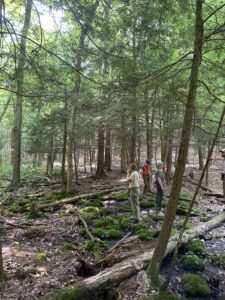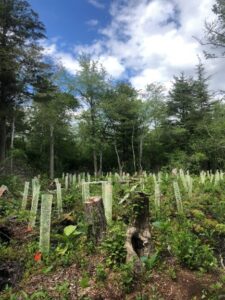
SNEC Land Stewardship Intern- Reflections at the Halfway Point
As I finish off Week 7 of my Land Stewardship Internship – just over halfway through – I am glad to have a chance to reflect on what I’ve accomplished, learned, and experienced with Avalonia so far. After meeting Toby, Mary Anne, and Ukiah at the office on my first day, I quickly got to work with Toby giving me a thorough explanation of Avalonia’s structure, introducing me to the integral Landscape software, and, of course, getting our feet on the ground right away at the nearest preserves.
 Participating in site visits to work with volunteers on-the-ground, to monitor issues of encroachment, to paint and post signs, or to walk with an Audubon representative, I’ve gradually gotten an understanding of what a day in the life of a Land Steward typically looks like – which is to say, atypical. The highly varied work that I’ve done so far has not only been extremely enriching mentally and physically but has also made me better prepared for future endeavors in conservation work. For example, I’ve learned that you should always have a long-sleeved shirt handy, and that two water bottles are better than one.
Participating in site visits to work with volunteers on-the-ground, to monitor issues of encroachment, to paint and post signs, or to walk with an Audubon representative, I’ve gradually gotten an understanding of what a day in the life of a Land Steward typically looks like – which is to say, atypical. The highly varied work that I’ve done so far has not only been extremely enriching mentally and physically but has also made me better prepared for future endeavors in conservation work. For example, I’ve learned that you should always have a long-sleeved shirt handy, and that two water bottles are better than one.
Restoration monitoring, which involves assessing the health of plantings, release cuttings, installing trail cameras, and trekking through some fairly aggressive swamp mud, has been a particularly informative and enjoyable work type for me. Although I’m hesitant to return after a recent bout with poison ivy, our trips to Anguilla Brook have shown me firsthand the arduous (yet rewarding) labor that goes into a restoration project. Seeing the Atlantic white cedar plantings thriving, identifying interesting vegetation (such as the little club-spur bog-orchid), and finding remnants of wildlife tracks make those trips well worth it. In other cases, where plantings are stressed, I am learning how to identify the problem and to start to think of solutions. Besides Anguilla Brook, I’ve done release cuttings for Dean’s Mill White Cedars, White Oaks at Sheet’s Family Forest, and checked on plantings at Yannatos Preserve.
Anguilla Brook have shown me firsthand the arduous (yet rewarding) labor that goes into a restoration project. Seeing the Atlantic white cedar plantings thriving, identifying interesting vegetation (such as the little club-spur bog-orchid), and finding remnants of wildlife tracks make those trips well worth it. In other cases, where plantings are stressed, I am learning how to identify the problem and to start to think of solutions. Besides Anguilla Brook, I’ve done release cuttings for Dean’s Mill White Cedars, White Oaks at Sheet’s Family Forest, and checked on plantings at Yannatos Preserve.

Another significant portion of my internship so far has been invasive assessment and management, particularly of Japanese Knotweed. Step 1 was learning how to identify key invasive species. Now, as I have completed some initial cuttings of the Knotweed, it has become abundantly clear how important prioritization and technique are. Matching species with their appropriate removal mechanism while factoring in the severity of the infestation, time available, habitat type, and the conservation values of a specific property seem to be a skill best learned through experience. Little by little, it feels as though my new experiences with Avalonia are leading to better and more relevant questions and decisions.
After spending the mornings in the field, and while the heat index climbs to scary figures, I typically have been returning to the office and its beloved AC units. There, I worked for the first few weeks researching trail policies, recreation ecology, and trail science. Reading from scientific journal articles, land manager forums, and other land trust manuals, I’ve grown to appreciate the complexities of balancing conservation and recreation values. I’m looking forward to seeing how this work fits into Avalonia policy creation. In that vein, I’ve had the opportunity to sit in on various committee meetings, learning more about the procedural underpinnings of Avalonia and get a feel for the architecture supporting the work I’ve gotten to see and help enact.
Looking forward to the upcoming month and next half of my internship with Avalonia, I am excited to see what more I can learn. Learning through action and experience has already significantly improved my understanding of land trust functioning, of volunteer-based non-profits, of tangible conservation action, and of myself and my own career goals. As someone attempting to orient themselves towards a life outdoors, I’m incredibly grateful for and inspired by this opportunity to work with Avalonia.
